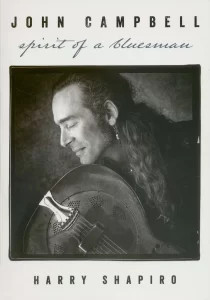For too long, the world has been waiting for a comprehensive exploration into the life and music of the late John Campbell, a blues guitarist of extraordinary talent. It’s remarkable that a figure as compelling as John Campbell, whose profound impact was captured in visceral prose by writers in OffBeat Magazine and Details, hasn’t been the subject of a full-length biography until now. Even Keith Spera’s deeply moving remembrance in OffBeat following Campbell’s untimely passing in 1993 at the age of 41 only scratched the surface of a story begging to be told.
 John Campbell Book Cover
John Campbell Book Cover
John Campbell’s career, though brief, was nothing short of meteoric. He ascended from relative obscurity, playing local gigs in Shreveport, Louisiana, and traversing the Ark-La-Tex circuit, to become a significant figure in the early 1990s blues revival. This rapid ascent is the stuff of legend, a narrative enriched by Campbell himself, a natural storyteller, and amplified by journalists who, admittedly, played a role in shaping his captivating persona.
Now, British blues authority Harry Shapiro, known for his acclaimed biographies of music icons like Hendrix, Clapton, and Jack Bruce, steps into the spotlight to illuminate John Campbell’s life. Shapiro’s journey with John Campbell’s music began in 1993, when he encountered Campbell’s powerful presence in the British blues magazine Blueprint. Captivated, Shapiro immediately acquired Campbell’s three essential albums: A Man And His Blues (1988), a German CrossCut release featuring Ronnie Earl, and his electrifying Elektra albums, One Believer (1991) and Howlin’ Mercy (1993), which garnered widespread acclaim from publications like Billboard and Rolling Stone, alongside the dedicated blues press. These albums showcased John Campbell’s unique blend of raw emotion and masterful guitar work, solidifying his place as a force in contemporary blues.
The impetus to delve deeper into John Campbell’s story resurfaced in 2020 when Shapiro rediscovered that old Blueprint article. Encouraged by John Campbell devotee Tom Geiger, who manages the Devil In My Closet Facebook page and had once considered writing a biography himself, Shapiro embarked on a serious quest to uncover the full narrative.
Shapiro’s dedication to this project is evident. His research is exhaustive, encompassing interviews with hundreds of individuals, including John Campbell’s family, bandmates, musical collaborators, friends, and fans. This encyclopedic approach is complemented by a thorough review of existing interviews and articles from Campbell’s vibrant career. The book’s depth is immense, venturing into detailed explorations, such as tracing every venue John Campbell played in Shreveport. For devoted blues enthusiasts, this meticulous detail will undoubtedly be a treasure trove.
The biography also unveils surprising aspects of John Campbell’s life, from connections to the Huey Long lineage to a newly revealed detail about his formative crossroads experience at age 16. The car accident that propelled him through a windshield, nearly costing him his sight, was made more perilous by the crutches he was using for a recent leg injury, highlighting the precarious circumstances surrounding this pivotal moment in his life.
Harry Shapiro deserves commendation for bringing John Campbell’s story to life. Whether you vividly recall John Campbell’s mesmerizing performances, perhaps his 1993 Jazz Fest appearance, or are just discovering his music, this book is an essential read. It portrays John Campbell not only as a virtuoso blues musician but also as a deeply human and generous soul.
As Dr. John poignantly stated in his eulogy at John Campbell’s 1993 memorial service in New York, “He gave us much more than music. He gave himself.” This biography ensures that the full breadth of that gift is finally recognized and celebrated.

